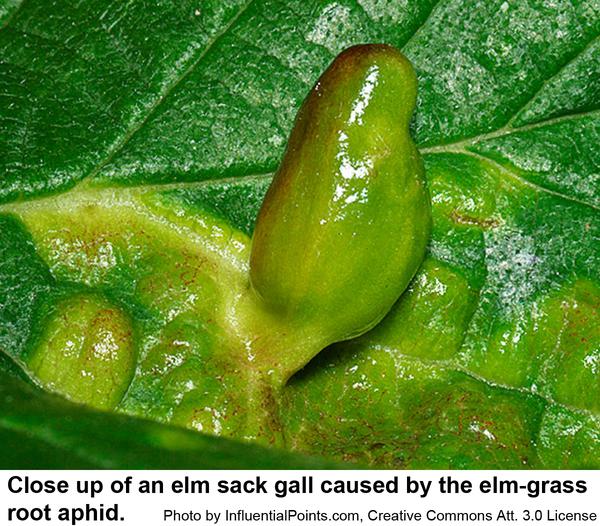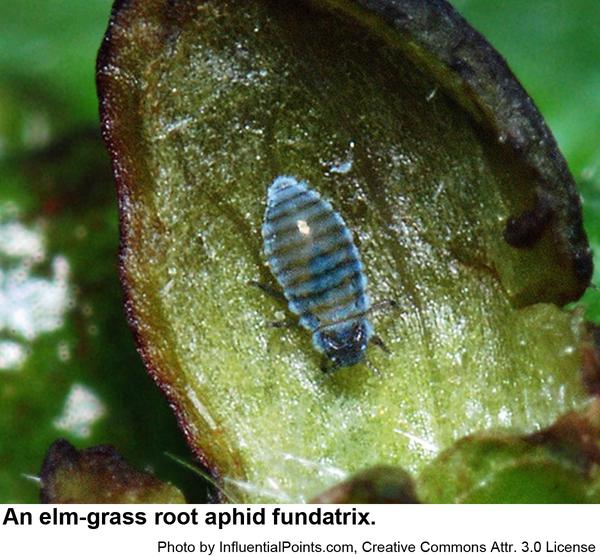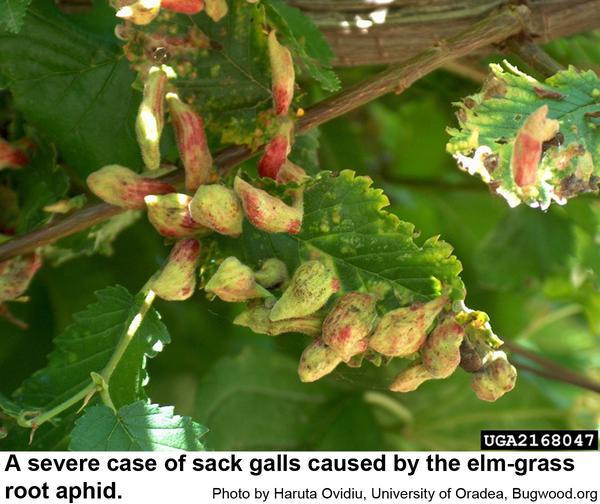Description and Biology
The elm-grass root aphid, Tetraneura ulmi, is also called the elm sack gall aphid. Winged forms fly from elm galls in June and July to colonize roots of grasses where they are usually tended by moisture ants in the genus Lasius. These aphids reproduce by giving birth to live nymphs. In September winged forms develop and return to elm where they produce nymphs that feed on the bark and eventually mature to wingless males and females. Fertilized females only lay one egg each. Eggs overwinter on the bark and hatch the following spring. These new nymphs develop over 3 to 4 weeks into a form called the fundatrix that "founds" a new generation of about 35 aphids. Fundatrices are dark green with transverse bands of light wax across the abdomen and thorax. Feeding on new elm leaves induces the leaf to form a sack gall about 3/8 inch tall inside of which the fundatrix gives birth to nymphs that eventually give birth to a second generation that develop wings. Up to 85 aphids have been found in one gall. The galls are stalked, hollow, and shiny green, yellow-green, or (eventually) red. In June and July, 3/32 to 1/8 inch long winged aphids develop that are shiny black with dark gray abdomens. When the galls crack open, these fly to grasses where they burrow down to feed on roots. Their offspring are fat, wingless, reddish-orange aphids that have very short siphunculi paired near the tail. Although standard protocol calls for elm-grass root aphids on grass roots to form winged forms that fly back to elm, some aphids ignore protocol and continue to feed on grass roots throughout the winter still tended by ants. Most of the aphids tended by ants are adults, and it is thought that ants eat any newly born aphids!
Host Plants
The elm-grass root aphid has been recorded from nine species of elms and from several grass species. Russian elm, Ulmus laevis, may not be a host. In July, infested leaves often drop from elms once the galls have cracked open to release winged aphids.
Residential Recommendations
Elm-grass root aphids overwintering on elm bark are preyed upon by minute pirate bugs, hover fly maggots, predaceous caterpillars, and birds. Usually by the time the sack galls are discovered on elms, it is too late for a pesticide application to "undo" the galls. Should a specimen elm important in the landscape be heavily infested year after year, a systemic insecticide could be applied during the winter to prevent gall formation next spring. If a tree is small enough to spray, an application of a systemic insecticide applied when the galls are new should control the aphids inside. One such systemic insecticide is imidacloprid available for landscape use in big box stores, garden centers, and nurseries (The active ingredient of every pesticide is listed on the front label although in very small type near the bottom).
Other Resources
- Tetraneura ulmi, Elm-grass root aphid. Anonymous. No Date. InfluentialPoints.com.
- Tetraneura ulmi (L.) (Hemipera, Eriosmatinae) on Elm as its Primary Host. Kmieć, K. and I. Kot. 2007. Aphids and Other Hemiperous Insects 13: 145-149.
- NC State Extension Plant Pathology Publications
- NC State Horticultural Science Publications
- North Carolina Agricultural Chemicals Manual
For assistance with a specific problem, contact your local Cooperative Extension center.
This factsheet has not been peer reviewed.
Publication date: Aug. 13, 2020
Reviewed/Revised: Aug. 15, 2025
Recommendations for the use of agricultural chemicals are included in this publication as a convenience to the reader. The use of brand names and any mention or listing of commercial products or services in this publication does not imply endorsement by NC State University or N.C. A&T State University nor discrimination against similar products or services not mentioned. Individuals who use agricultural chemicals are responsible for ensuring that the intended use complies with current regulations and conforms to the product label. Be sure to obtain current information about usage regulations and examine a current product label before applying any chemical. For assistance, contact your local N.C. Cooperative Extension county center.
N.C. Cooperative Extension prohibits discrimination and harassment regardless of age, color, disability, family and marital status, gender identity, national origin, political beliefs, race, religion, sex (including pregnancy), sexual orientation and veteran status.





